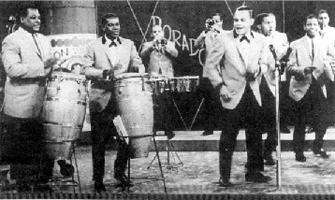
|
| “during the plena’s third historical stage, the 1950s and 1960s, black musicians Mon Rivera, Rafael Cortijo, and Ismael Rivera vindicated the plena, doing away with what they saw as trivial entertainment, and returned it to the black Puerto Rican proletariat from which it originally emerged by making ‘full use of recording technology’ and creating ‘ingenious innovations to style.’ In this sense, Rafael Cortijo, like African-America rappers today, reappropriated the tools of the master- technology- to reaffirm the musical and cultural presence of the marginalized.”2 (Aparicio, Frances “listening to salsa” pg 34) |
In this moment in time, Afro-Puerto Ricans were finally able to reaffirm their cultural identity. All of their efforts gave rise to a representational shift; allowing black musicians to undermine the negative stereotypes that had been associated to black people for centuries and finally gave them the opportunity to represent themselves and blackness in a positive light.
Curet is one of Puerto Ricos’s most influential and known composers of the 20th century. A recurring theme that can be seen in many of the songs he has composed over time is the “Africanized nationalistic dignity.” The struggle of black people in latin America can be seen in several of his songs like “El Conde” and “La Abolicion.”
| “Through Cheo, Curet told the folk tale of the valiant “Anacaona,” a Taino Indian “Cacica” (chief) from the Dominican Republic who speaks of a long awaited struggle for her elusive freedom and break from slavery.”3 |
He was also the composer of “La caras linda de mi gente negra,” “El Mesias/ El cristo negro,” and “lo entierro de mi gente negra.” These songs were specifically written about the way he perceives his black people in society and provides its listeners with an insight into his spiritual and religious beliefs, which are also strongly influenced by his African rooted culture. In his song “Caras Lindas” he describes the faces of his black people as beautiful. In his lyrics he doesn’t only portray his people as physically beautiful but also refers to them as very loving and happy people regardless of the realistic harsh parts of life that they have had to encounter as a people. To him, black people are seen as beautiful, inside and out.

Lyrics: Caras lindas “Las caras lindas de mi gente negra |
In this song he talks about giving a bouquet of colorful spring roses to someone who does not even remember him. Although the person has forgotten who he is he wants to offer them roses and in his last line, “la mujer es una rosa con espinas de pasión,“ he uses metaphor to describe women as roses with thorns of passion.
Song title: De todas maneras rosa
Artist: Ismael Rivera
De todas maneras rosas
para quien ya me olvidó,
mas vale un ramo de rosas
de primavera y color. (2x)
Aunque el hastío
la diferencia, el olvido,
caigan sobre lo vivido
al final como el telón.
Yo traigo un ramo
un ramo de lindas flores
de perfumados colores
para quien ya me olvido.
De todas maneras rosas
para quien ya me olvido,
la mujer es una rosa
con espinas de pasión.
Coro:
Rosas, rosas, de todas maneras rosas.
Notes:
-
Anonymous., “The legacy of Negrismo/ Negritude: Inter-American Dialogues.” Guest editor’s introduction in The Langston Hughes Review 16:2. 1999-2001
-
Aparicio, Frances R., “Listening to Salsa: Gender, Latin Popular music, and Puerto Rican Cultures.”Wesleyan university Press.
-
Flores, Aurora., “A Man & His Music: Tite Curet Alonso.” 2008 http://groups.google.com/group/rec.music.afro-latin/browse_thread/thread/43a3f111ded8b7ab
-
Lyrics for “ Caras lindas” - http://www.musica.com/letras.asp?letra=1046457
Further Reading :
- Flores, Juan."Cortijo’s Revenge: New Mappings Of Puerto Rican Culture." Divided Borders: Essays on Puerto Rican Identity. Houston: Arte Público, 1993. 92-107. Print.
- Aparicio, Frances R.,“Listening to Salsa: Gender, Latin Popular music, and Puerto Rican Cultures.” Wesleyan University Press. 1998.
